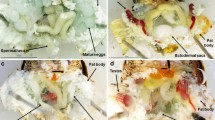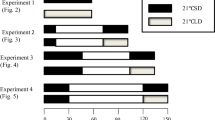Abstract
The onset of larval diapause in the burnet moth Zygaena trifolii is clearly characterized by the larva molting into a specialized dormant morph. In a potentially bivoltine Mediterranean population (Marseille) two types of diapause can occur within 1 year: firstly, a facultative summer diapause of 3–10 weeks, and secondly, an obligate winter diapause, which can be lengthened by a period of thermal quiescence to several months in temperatures of ≤5°C. For the first time, three successive physiological periods have been experimentally distinguished within an insect dormancy (between onset of diapause and molting to the next non-diapause stage), using chilling periods of 30–180 days at 5°C, and varying conditions of photoperiod and temperature. These stages are: (1) a continuous Diapause-ending process (DEP); (2) thermal quiescence (Q); and finally, (3) a period of postdiapause development (PDD) before molting to the next larval instar. The result of transferring dormant larvae from chilling at 5°C to 20°C depended on the length of the chilling period. After chilling for 120–180 days, molting to the next instar occurred after 6–10 days, independent of daylength. This period corresponds with the duration of PDD. After shorter chilling periods (90, 60, 30 days and the control, 0 days) the period to eclosion increased exponentially, and included both the latter part of the previous diapause process and the 6–10 day period of PDD. However, photoperiod also influences the time to eclosion after chilling. Short daylength (8 h light / 16 h dark: LD 8/16) lengthened the diapause in comparison to long daylength (16 h light / 8 h dark: LD 16/8). Short daylength had a similar effect during chilling at 5°C, as measured by the longer time to eclosion after transfer. The shorter time to eclosion resulting from longer chilling periods (30–90 days) demonstrates that the state of diapause is continuously shortened at 5°C, and corresponds to the neuroendocrine controlled DEP. Presumably the DEP has already started after the onset of diapause. When chilling was continued after the end of the DEP, which ranged between 90 and 120 days, thermal quiescence (Q) followed (observed maximum 395 days). Different photoperiodic conditions during the pre-diapause inductive period modified diapause intensity (measured as the duration of diapause), in that a photoperiodic signal just below the critical photoperiod for diapause induction (LD 15/9) intensified diapause. Experiments simulating the summer diapause showed that PDD occurred in the range of 10–25°C. Higher temperatures (15 and 20°C) shortened the DEP at LD 16/8, so that at 20°C many individuals had already terminated diapause after 10–40 days and had molted after the 6–10 days of PDD. A temperature of 25°C unexpectedly lengthened the DEP to 110 days in several individuals. The ecological consequences and the adaptive significance of variation in the duration of the diapause are discussed in relation to the persistence of local populations predictably variable and rare climatic extremes throughout the year.
Similar content being viewed by others
References
Andrewartha HG (1952) Diapause in relation to the ecology of insects. Biol Rev 27:50–107
Beck SD (1980) Insect photoperiodism. Academic Press, New York
Beck SD (1989) Factors influencing the intensity of larval diapause in Ostrinia nubilalis. J Insect Physiol 35:75–79
Boer PJ den (1973) Das Überleben von Populationen und Arten und die Bedeutung von Umweltheterogenität. Verh Dtsch Zool Ges 66:125–135
Burgeff H (1910) Beiträge zur Biologie der Gattung Zygaena II. Z Wiss Ins Biol 6:39–44, 97–98
Burgeff H (1921) Beiträge zur Biologie der Gattung Zygaena IV. Mitt Münch Entomol Ges 11:50–64
Cohen D (1970) A theoretical model for the optimal timing of diapause. Am Nat 104:389–400
Collier R H, Finch S (1983) Effects of intensity and duration of low temperatures in regulating diapause development of the cabbage root fly (Delia radicum). Entomol Exp Appl 34:186–192
Danks HV (1987) Insect dormancy: an ecological perspective. Tyrell Press, Gloucester, Ontario
den Boer PJ (1971) Stabilization of animal numbers and the heterogeneity of the environment: The problem of the persistence of sparse populations. In: den Boer PJ, Gradwell GR (eds) Dynamics of Populations [Proceedings of the Advanced Study Institute on ‘Dynamics of Numbers in Populations’, (Oosterbeek, the Netherlands, 7–18 September 1970)]. Wageningen, Centre Agr Publ Docum, pp 77–79
Denlinger DL, Bradfield JY (IV) (1980) Programming the duration of pupal diapause in the tobacco hornworm. Am Zool 20:937
Denlinger DL, Bradfield JY (IV) (1981) Duration of the pupal diapause in the tobacco hornworm is determined by number of short days received by the larva. J Exp Biol 91:331–337
Dryja A (1959) Badania nad polimorfizmen krasnika zmiennego. (Zygaena ephialtes) (Genetical investigations on the polymorphism of Zygaena ephialtes) (in Polish with English summary) Pañstwowe Wydawmictwo Naukowe, Warsaw
Furusawa T, Shikata M, Yamashita O (1982) Temperature dependent sorbitol utilization in diapause eggs of the silkworm Bombyx mori. J Comp Physiol B 147:21–26
Gomi T, Takeda M (1992) A quantitative photoperiodic response terminates summer diapause in the tailed zygaenid moth Elcysma westwoodii. J Insect Physiol 38:665–670
Grüner C, Sauer KP (1988) Aestival dormancy in the cabbage moth M. brassicae. 1. Adaptive significance of variability of two traits: day length thresholds triggering aestival dormancy and the duration of aestival dormanyy. Oecologia 74:515–523
Grüner C, Masaki S (1994) Summer diapause in the polymorphic life cycle of the noctuid moth Mamestra brassicae. In: Danks HV (ed), Insect life-cycle polymorphism: theory, evolution and ecological consequences for seasonality and diapause control. Wolters Kluwer, Amsterdam, pp 191–204
Ishii M, Hidaka T (1982) Characteristics of pupal diapause in the univoltine papilionid Luehdorfia japonica. Kontyû 50:610–620
Ishii M, Johki Y (1977) (Termination of prepupal diapause in Elcysma westwoodii) (in Japanese). Tyô to Ga 28:170
Ishii M, Johki Y, Hidaka T (1983) Studies on summer diapause in zygaenid moths. I. Factors affecting the pupal duration in Pryeria sinica. Kontyû 51:122–127
Lees AD (1955) The physiology of diapause in arthropods. Cambridge University Press, Cambridge
Mansingh A (1971) Physiological classification of dormancies in insects. Can Zool 103:983–1009
Masaki S (1959) Seasonal changes in the mode of diapause in the pupae of Abraxas miranda Butler. Bull Fac Agric Hirosaki Univ 5:14–27
Masaki S (1961) Geographic variation of diapause in insects. Bull Fac Agric Hirosaki Univ 7:66–98
Masaki S, Ando Y, Watanabe A (1979) High temperature and diapause termination in the eggs of Teleogryllus commodus. Kontyû 47:493–504
Masaki S, Shirado I, Nagase A (1987) Tropical, subtropical and temperate life cycles in ground crickets. Insect Sci Appl 8:475–481
Masaki S, Nagase A (1992) Genetics, variability and origin of tropical, subtropical and temperate life cycles in the Dianemobius fascipes species-complex. Stud Neotrop Fauna Environ 27:69–82
Pörschmann M (1986) Morphologische und habituelle Parameter im larvalen Entwicklungszyklus von Zygaena trifolii. Diplom-Thesis, Universität Bielefeld
Sauer KP, Grüner C (1988) Aestival dormancy in the cabbage moth M. brassicae. 2. Geographical variation in two traits: day length thresholds triggering aestival dormancy and the duration of aestival dormancy. Oecologia 76:89–96
Sachs L (1992) Statistische Auswertungsmethoden. Springer, Berlin Heidelberg New York
Saunders DS (1982) Insect clocks. Pergamon, Oxford
Schneiderman HA, Horwitz J (1958) The induction and termination of facultative diapause in the chalcid wasps Mormoniella vitripennis (Walker) and Trineptis klugii (Ratzeburg). J Exp Biol 35:520–531
Skopik S, Takeda M (1987) Diapause induction and termination: north-south strain differences in Ostrinia nubilalis. J Biol Rhythm 2:13–22
Tauber MJ, Tauber CA, Masaki S (1984) Adaptations to hazardous seasonal conditions: dormancy, migration and polyphenism. In: Huffaker CB, Rabb RL (eds) Ecological entomology. Wiley, New York, pp 149–183
Tauber MJ, Tauber CA, Masaki S (1986) Seasonal adaptations of insects. Oxford University Press, New York
Uebel W (1974) Zygaenenzuchten. Mitt Entomol Ver Stuttgart 9:43–61
Wipking W (1987) Ökologische Untersuchungen über die Diapauseregulation bei westpaläarktischen Stämmen einer Schmetterlingsfamilic (Ins., Lepidoptera, Zygaenidae). Ph D Thesis, Universität zu Köln
Wipking W (1988a) Repeated larval diapause and diapause-free development in geographic strains of the burnet moth Zygaena trifolii Esp. I. Discontinuous clinal variation in photoperiodically controlled diapause induction. Oecologia 77:557–564
Wipking W (1988b) Bivoltinismus und repetitive Larvaldiapause bei Zygaena trifolli ESP. Verh Dtsch Zool Ges 81:334–335
Wipking W (1990) Facultative and obligatory diapause responses in three species of burnet moths: a characterization of life-cycle phenologies by field observations and laboratory experiments. In: Gilbert F (ed), Genetics, evolution and coordination of insect life cycles. Springer, Berlin Heidelberg New York, pp 229–241
Wipking W (1992) Cold hardiness in the caterpillars of burnet and forester moths. In: Dutreix C, Naumann CM, Tremewan WG (eds) Recent advances in burnet moth research. Theses Zool 19:129–143
Wipking W (1993) Die larvale Diapause bei alpinen und nördlichen Blutströpfchenschmetterlingen-Versuche zu induzierenden Kurztagbedingungen, verlängerten Entwicklungsgeschwindigkeiten, frühen und späten Diapausestadien und deren hormonaler Kontrolle. Verh Dtsch Zool Ges 86:14
Wipking W, Naumann CM (1992) Diapause and related phenomena in Zygaenidae moths. In: Dutreix C, Naumann CM, Tremewan WG (eds) Recent advances in burnet moth research. Theses Zool 19:107–128
Wipking W, Neumann D (1986) Polymorphism in the larval hibernation strategy of the burnet moth Zygaena trifolii. In: Taylor F, Karban R (eds) The evolution of insect life cycles. Springer, Berlin Heidelberg New York, pp 125–134
Wipking W, Viebahn M, Neumann D (1995) Oxygen consumption, water, lipid and glycogen content of early and late diapause and non-diapause larvae of the burnet moth Zygaena trifolii. J Insect Physiol 41:47–56
Author information
Authors and Affiliations
Rights and permissions
About this article
Cite this article
Wipking, W. Influences of daylength and temperature on the period of diapause and its ending process in dormant larvae of burnet moths (Lepidoptera, Zygaenidae). Oecologia 102, 202–210 (1995). https://doi.org/10.1007/BF00333252
Received:
Accepted:
Issue Date:
DOI: https://doi.org/10.1007/BF00333252




